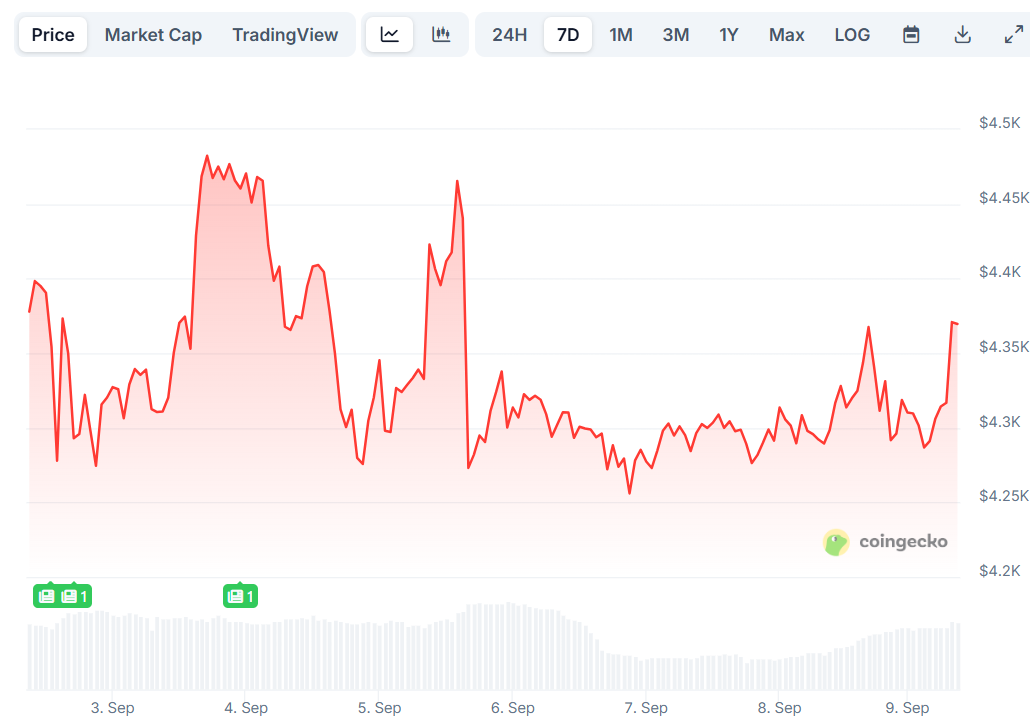Ethereum (ETH) Price Prediction: Seven Days of Selling Pressure Test Bulls’ Resolve
TLDR
- Ethereum price has struggled to break above $4,500 resistance for over 10 days, forming lower highs since August peak
- Spot Ethereum ETFs experienced massive outflows totaling $912 million over seven consecutive days
- Network activity and revenue declined 44% in August despite price hitting all-time highs near $4,950
- Technical analysis shows descending triangle pattern pointing to potential drop toward $3,550 support level
- Futures open interest fell 18% from $70 billion peak, indicating reduced market participation and leverage demand
Ethereum’s price remains trapped below the $4,500 resistance level as investors pull $912 million from spot ETFs over seven straight trading days. The second-largest cryptocurrency by market cap has failed to sustain momentum above this key threshold for more than 10 days.
 Ethereum (ETH) Price
Ethereum (ETH) Price
The selling pressure reflects broader market caution despite supportive economic conditions. Digital asset investment products lost $352 million last week as trading volumes dropped 27% week-over-week.
Ethereum’s price action shows clear weakness compared to earlier this year. The token reached all-time highs of $4,950 on August 14 before forming a series of lower highs and lower lows on daily charts.
Current price levels around $4,372 represent a retreat from those peaks. The $4,500 level has now flipped from support to resistance, creating a technical barrier for bulls.
Spot volume data reveals the underlying problem facing Ethereum. The volume delta metric shows negative net buying on exchanges even during consolidation periods. This suggests limited real demand to drive prices higher.
Without fresh buying interest, any breakout attempts above $4,500 may lack the strength needed for sustained gains. The absence of new buyers has become a critical factor limiting upward movement.
ETF Outflows Paint Bearish Picture
Spot Ethereum ETF flows tell a concerning story for institutional interest. These investment products posted outflows every single day last week according to SoSoValue data.
Friday alone saw $446.8 million leave Ethereum ETFs. Total weekly outflows reached $787.6 million, erasing monthly gains completely.
The outflows came from diverse ETP providers rather than concentrated selling from single sources. This broad-based withdrawal pattern suggests widespread institutional caution rather than isolated profit-taking.
Year-to-date, Ethereum still maintains $11.2 billion in total inflows. However, the recent exodus has eliminated August gains and raised questions about near-term institutional appetite.
Regional flow data shows the United States led outflows with $440 million. Sweden and Switzerland also posted withdrawals of $13.5 million and $2.7 million respectively.
Network Fundamentals Show Cracks
Ethereum’s on-chain metrics present mixed signals about underlying network health. Revenue dropped 44% in August to $14.1 million from July’s $25.6 million despite price gains.
Network fees also declined approximately 10% over the past 30 days to $43.3 million. This decrease comes as transaction activity on the base layer slowed.
The Dencun upgrade implemented in March 2024 continues impacting fee structures. The upgrade reduced transaction costs for layer-2 networks using Ethereum as their base layer.
Lower fees benefit users but reduce revenue flowing to ETH holders through token burns. This impacts Ethereum’s deflationary mechanism and may weaken long-term price support.
Futures markets show similar cooling trends. Open interest fell 18% to $58 billion from the August 23 peak of $70 billion. Declining open interest typically indicates reduced leverage and market participation.
The technical picture points toward further downside risk. Ethereum has formed a descending triangle pattern since mid-August with flat support around $4,200 and declining resistance.
A break below $4,200 support could trigger moves toward $3,550 based on the pattern’s measured target. This represents an 18% decline from current levels.
Some analysts see potential bounces before deeper drops. Ted Pillows noted ETH looks strong above $4,200 but expects possible retests of $3,800-$3,900 ranges.
The $3,745 level represents another key support zone if current ranges fail to hold.
Current market structure suggests Ethereum faces multiple headwinds limiting upside potential while technical patterns point toward lower support tests in coming sessions.
The post Ethereum (ETH) Price Prediction: Seven Days of Selling Pressure Test Bulls’ Resolve appeared first on CoinCentral.
You May Also Like

Cardano Price Prediction: Is ADA About To Tumble Over 25% As Investors Search For Meme Coins For Maximum Gains

ZK-Rollup: The Future of Blockchain Scalability
